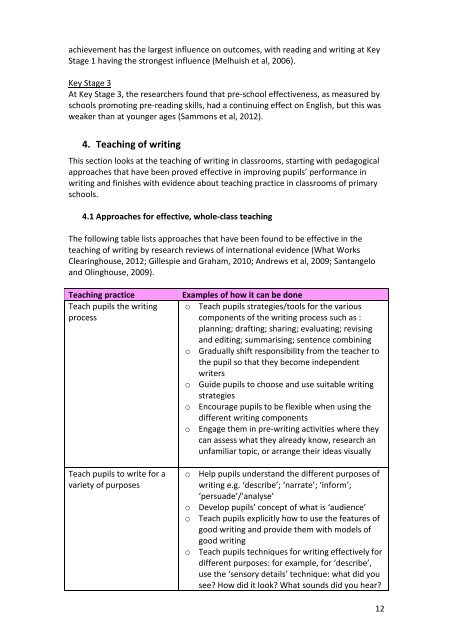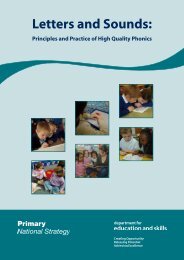What is the research evidence on writing? - Department for Education
What is the research evidence on writing? - Department for Education
What is the research evidence on writing? - Department for Education
You also want an ePaper? Increase the reach of your titles
YUMPU automatically turns print PDFs into web optimized ePapers that Google loves.
achievement has <str<strong>on</strong>g>the</str<strong>on</strong>g> largest influence <strong>on</strong> outcomes, with reading and <strong>writing</strong> at Key<br />
Stage 1 having <str<strong>on</strong>g>the</str<strong>on</strong>g> str<strong>on</strong>gest influence (Melhu<str<strong>on</strong>g>is</str<strong>on</strong>g>h et al, 2006).<br />
Key Stage 3<br />
At Key Stage 3, <str<strong>on</strong>g>the</str<strong>on</strong>g> <str<strong>on</strong>g>research</str<strong>on</strong>g>ers found that pre-school effectiveness, as measured by<br />
schools promoting pre-reading skills, had a c<strong>on</strong>tinuing effect <strong>on</strong> Engl<str<strong>on</strong>g>is</str<strong>on</strong>g>h, but th<str<strong>on</strong>g>is</str<strong>on</strong>g> was<br />
weaker than at younger ages (Samm<strong>on</strong>s et al, 2012).<br />
4. Teaching of <strong>writing</strong><br />
Th<str<strong>on</strong>g>is</str<strong>on</strong>g> secti<strong>on</strong> looks at <str<strong>on</strong>g>the</str<strong>on</strong>g> teaching of <strong>writing</strong> in classrooms, starting with pedagogical<br />
approaches that have been proved effective in improving pupils’ per<strong>for</strong>mance in<br />
<strong>writing</strong> and fin<str<strong>on</strong>g>is</str<strong>on</strong>g>hes with <str<strong>on</strong>g>evidence</str<strong>on</strong>g> about teaching practice in classrooms of primary<br />
schools.<br />
4.1 Approaches <strong>for</strong> effective, whole-class teaching<br />
The following table l<str<strong>on</strong>g>is</str<strong>on</strong>g>ts approaches that have been found to be effective in <str<strong>on</strong>g>the</str<strong>on</strong>g><br />
teaching of <strong>writing</strong> by <str<strong>on</strong>g>research</str<strong>on</strong>g> reviews of internati<strong>on</strong>al <str<strong>on</strong>g>evidence</str<strong>on</strong>g> (<str<strong>on</strong>g>What</str<strong>on</strong>g> Works<br />
Clearinghouse, 2012; Gillespie and Graham, 2010; Andrews et al, 2009; Santangelo<br />
and Olinghouse, 2009).<br />
Teaching practice Examples of how it can be d<strong>on</strong>e<br />
Teach pupils <str<strong>on</strong>g>the</str<strong>on</strong>g> <strong>writing</strong><br />
process<br />
Teach pupils to write <strong>for</strong> a<br />
variety of purposes<br />
o Teach pupils strategies/tools <strong>for</strong> <str<strong>on</strong>g>the</str<strong>on</strong>g> various<br />
comp<strong>on</strong>ents of <str<strong>on</strong>g>the</str<strong>on</strong>g> <strong>writing</strong> process such as :<br />
planning; drafting; sharing; evaluating; rev<str<strong>on</strong>g>is</str<strong>on</strong>g>ing<br />
and editing; summar<str<strong>on</strong>g>is</str<strong>on</strong>g>ing; sentence combining<br />
o Gradually shift resp<strong>on</strong>sibility from <str<strong>on</strong>g>the</str<strong>on</strong>g> teacher to<br />
<str<strong>on</strong>g>the</str<strong>on</strong>g> pupil so that <str<strong>on</strong>g>the</str<strong>on</strong>g>y become independent<br />
writers<br />
o Guide pupils to choose and use suitable <strong>writing</strong><br />
strategies<br />
o Encourage pupils to be flexible when using <str<strong>on</strong>g>the</str<strong>on</strong>g><br />
different <strong>writing</strong> comp<strong>on</strong>ents<br />
o Engage <str<strong>on</strong>g>the</str<strong>on</strong>g>m in pre-<strong>writing</strong> activities where <str<strong>on</strong>g>the</str<strong>on</strong>g>y<br />
can assess what <str<strong>on</strong>g>the</str<strong>on</strong>g>y already know, <str<strong>on</strong>g>research</str<strong>on</strong>g> an<br />
unfamiliar topic, or arrange <str<strong>on</strong>g>the</str<strong>on</strong>g>ir ideas v<str<strong>on</strong>g>is</str<strong>on</strong>g>ually<br />
o Help pupils understand <str<strong>on</strong>g>the</str<strong>on</strong>g> different purposes of<br />
<strong>writing</strong> e.g. ‘describe’; ‘narrate’; ‘in<strong>for</strong>m’;<br />
‘persuade’/’analyse’<br />
o Develop pupils’ c<strong>on</strong>cept of what <str<strong>on</strong>g>is</str<strong>on</strong>g> ‘audience’<br />
o Teach pupils explicitly how to use <str<strong>on</strong>g>the</str<strong>on</strong>g> features of<br />
good <strong>writing</strong> and provide <str<strong>on</strong>g>the</str<strong>on</strong>g>m with models of<br />
good <strong>writing</strong><br />
o Teach pupils techniques <strong>for</strong> <strong>writing</strong> effectively <strong>for</strong><br />
different purposes: <strong>for</strong> example, <strong>for</strong> ‘describe’,<br />
use <str<strong>on</strong>g>the</str<strong>on</strong>g> ‘sensory details’ technique: what did you<br />
see? How did it look? <str<strong>on</strong>g>What</str<strong>on</strong>g> sounds did you hear?<br />
12
















